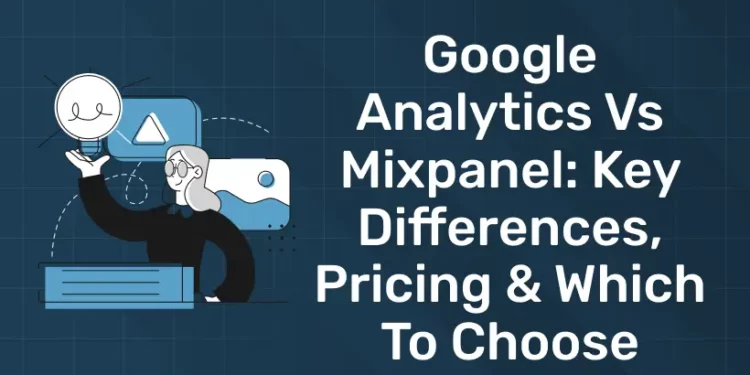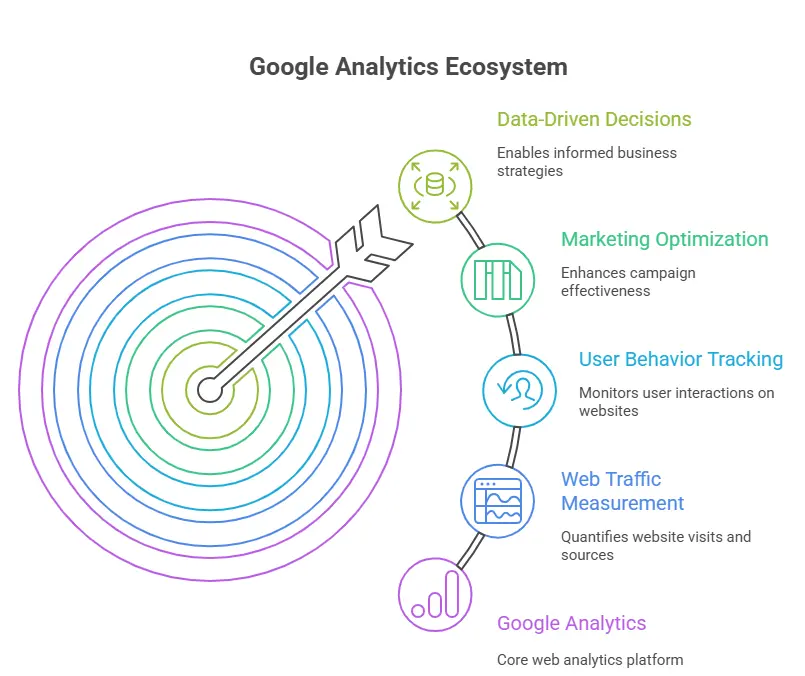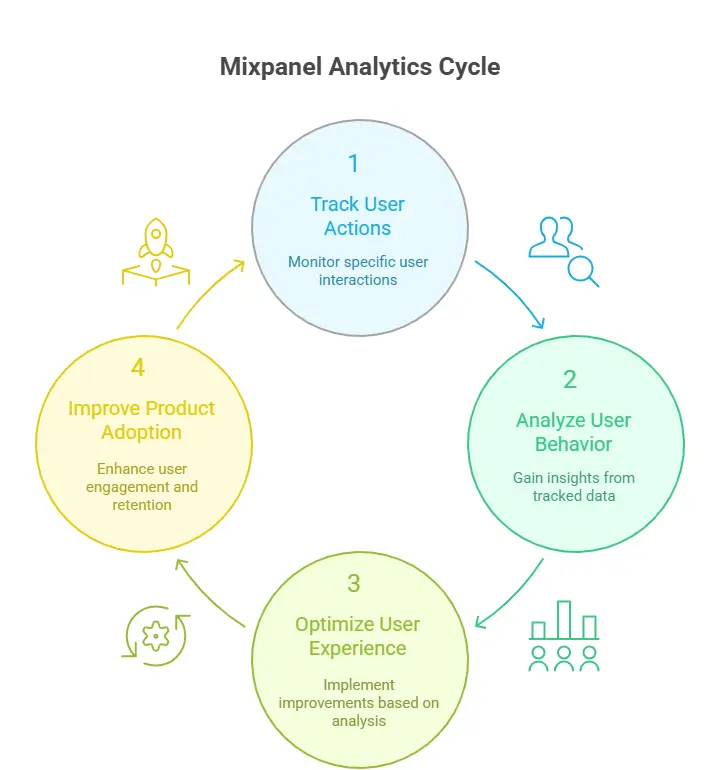Table of Contents
Choosing the proper analytics device can be difficult for many businesses. Google Analytics and Mixpanel are two popular alternatives, however they serve exceptional purposes. Google Analytics is terrific for monitoring website traffic and marketing outcomes, even as Mixpanel focuses on information user behavior and product utilization. In this blog, we’re going to explore their key differences, pricing, real-world examples, so that you can determine which one is best for your business needs.
Join Our Online Digital Marketing Course & Learn the Fundamentals!
Introduction
In these days’s virtual global, groups are flooded with information, but making feel of it is a real project. Many organizations warfare to pick the right analytics device that can offer meaningful insights and help force smarter selections. Two of the most famous options are Google Analytics and Mixpanel, each presenting precise functions for tracking user conduct, measuring overall performance, and optimizing growth.
Analytics has end up important for data-driven choice-making, whether or not it’s know-how client trips, enhancing internet site performance, or fine-tuning advertising campaigns. While Google Analytics has been the pass-to preference for years, providing a huge range of popular metrics and clean-to-use reporting, Mixpanel focuses extra on occasion-primarily based analytics, supporting companies analyze precise consumer movements in element.
The debate between Google Analytics vs Mixpanel regularly comes right down to the kind of insights a commercial enterprise wishes, its size, and its analytics desires. In this article, we’ll give the important thing differences, pricing, and use cases, supporting making a decision which tool is the right suit to your commercial enterprise.
What is Google Analytics?
1: What is the primary goal of SEO (Search Engine Optimization)?
Google Analytics is one of the most extensively used web analytics tools within the international, helping groups apprehend how customers interact with their web sites. It changed into first released in November 2005 after Google received Urchin Software Corporation. Since then, it has developed right into a robust platform, currently to be had as Google Analytics four (GA4), supplying superior tracking, reporting, and analysis functions.
The primary motive of Google Analytics is to assist corporations measure web site visitors, music user conduct, and optimize advertising and marketing campaigns. It provides insights into metrics like web page perspectives, consultation length, jump rates, conversion quotes, and person demographics. Businesses can see in which their visitors is coming from—including search engine, social media, or paid campaigns—and make statistics-driven decisions to improve performance and engagement.
Google Analytics is in particular best for small to medium-sized companies and advertising teams that want easy-to-understand reviews and actionable insights without requiring heavy technical understanding.
Pros of Google Analytics:
- Free and smooth to installation (GA4 has a loose version).
- It provides precise website visitors, advertising and the marketing insights.
- They integrates seamlessly with the Google Ads and other Google equipment.
- User-friendly interface with some pre-constructed reports.
Cons of Google Analytics:
- Limited in tracking unique person interactions in comparison to occasion-based gear like Mixpanel.
- Can be overwhelming for novices because of the wide variety of metrics.
- Data sampling may occur for high-visitors web sites in the free version.
Also the Google Analytics is a dependable tool for agencies that want to apprehend the website’s overall performance, optimize the advertising efforts, and make knowledgeable selections based on the records.
Become an AI-powered Digital Marketing Expert
Master AI-Driven Digital Marketing: Learn Core Skills and Tools to Lead the Industry!
Explore CourseWhat is Mixpanel?
Mixpanel is a powerful product analytics device designed to help organizations understand how users engage with their digital products, in location of simply tracking web page views. Founded in 2009, Mixpanel focuses on event-based definitely analytics, which means that it tracks specific patron actions like button clicks, sign-ups, purchases, or feature usage.
Mixpanel is mainly perfect for SaaS organizations, cell apps, and product-targeted teams. It helps product managers, entrepreneurs, and developers recognize how users navigate via their apps, which functions are most famous, and wherein users drop off. With Mixpanel, businesses can create custom funnels, cohort analyses, and retention reviews, allowing them to optimize the user experience and beautify product adoption.
Pros of Mixpanel:
- They provides distinctive, occasion-primarily based analytics for the precise consumer insights.
- Excellent for tracking the user journeys, retention, and engagement.
- Provide customizable dashboards and reports for the product and marketing teams.
- Strong consciousness on actionable insights for the product development.
Cons of Mixpanel:
- Can be more complicated and may require training to apply successfully.
- Pricing can be excessive for groups with large person bases or information volumes.
- Less targeted on traditional internet site visitors metrics as compared to Google Analytics.
Key Differences: Google Analytics vs Mixpanel
Google Analytics and Mixpanel are two stable frameworks, but each is designed to fulfill different commercial enterprise wishes. While Google Analytics is popular for advertising and marketing and internet site analytics, Mixpanel is built for product-centered groups and offers extra advanced consumer conduct analysis. The following is a complete overview to help you perceive which tool is a better suit to your commercial enterprise needs.
| Feature | Google Analytics | Mixpanel |
|---|---|---|
| Data Focus | Primarily advertising and internet site analytics. Tracks sessions, web page perspectives, demographics, and marketing campaign performance. | Focuses on product analytics. Tracks precise user movements like clicks, sign-ups, and characteristic utilization. |
| Event Tracking & Funnels | Tracks basic activities like clicks and shape submissions. Funnel analysis exists but has boundaries in flexibility. | Built for event-based tracking. Tracks targeted person movements with absolutely customizable funnels. |
| Ease of Setup & Learning Curve | Easy setup with Google Tag Manager. Beginner-pleasant dashboards appropriate for marketers. | Setup is technical. Requires defining occasions and information product flows; may also need group training. |
| Customization & Reporting | Provides pre-built dashboards and reviews. Limited customization within the unfastened version. | Highly customizable dashboards and reviews. Supports advanced segmentation, cohort evaluation, and retention reports. |
| Real-Time Data | Shows actual-time lively customers, web page views, and marketing campaign visitors, but granularity is restrained. | Offers designated actual-time insights, inclusive of person engagement, movements, and retention metrics. |
| Integrations | Seamless integration with Google Ads, Search Console, BigQuery, and other Google products. |
Integrates with CRM, advertising automation equipment, SaaS structures, and helps custom API integrations.
|
| Privacy & Compliance | GA4 is privateness-centered with IP anonymization, consent mode, and GDPR compliance. | GDPR and CCPA compliant. Allows product groups manipulate over person-degree statistics privacy. |
1. Data Focus: Marketing vs Product Analytics
One of the main variations among Google Analytics and Mixpanel is the type of records they cognizance on.
- Google Analytics: Primarily tracks website performance. It’s ideal for organizations that want to screen website online site visitors sources, internet page perspectives, patron demographics, and advertising and marketing marketing marketing campaign effectiveness. Marketers can see how clients arrive at a internet web page, which pages maintain them engaged, and which campaigns force conversions.
- Mixpanel: Focuses on product analytics, assisting groups recognize how clients interact with a product or app. It tracks unique events, like which capabilities users click on, how often they return, and in which they drop off. This is treasured for improving retention, engagement, and product experience.
2. Event Tracking & Funnels
Event monitoring and funnel analysis are vital for know-how person conduct:
- Google Analytics: Offers fundamental occasion tracking for clicks, shape submissions, downloads, and conversions. Funnels are available however have restricted flexibility, mainly for multi-step product flows. It works first-rate for monitoring advertising and marketing dreams.
- Mixpanel: Designed for superior event-based monitoring. Teams can create custom funnels, music detailed person trips, and display wherein customers drop off in multi-step techniques. This is specially useful for SaaS products, apps, and digital offerings that rely on consumer engagement.
3. Ease of Setup & Learning Curve
Ease of use is essential for businesses with out committed analytics groups:
- Google Analytics: Easy to set up, mainly with Google Tag Manager. The interface is intuitive, making it perfect for novices or marketers who want short insights with out complicated configurations.
- Mixpanel: Requires extra technical setup. Events have to be described earlier, and product teams often want training to use the tool effectively. While it provides extra distinct insights, the mastering curve can be steep for brand spanking new customers.
4. Customization & Reporting
Reporting capabilities are every other key distinction:
- Google Analytics: Offers standard dashboards and reports. Users can customize to a degree, but the loose GA4 version has boundaries. It’s enough for primary marketing insights however might not meet the wishes of product teams that require detailed analysis.
- Mixpanel: Highly flexible with custom dashboards, segmentation, and cohort reviews. Teams can examine consumer retention, engagement, and conversion intensive. This customization is right for product managers and builders aiming to enhance capabilities and optimize person enjoy.
5. Real-Time Data
Real-time analytics enables groups react speedy to tendencies:
- Google Analytics: Shows actual-time active users, web page perspectives, and visitors assets. Useful for tracking campaigns or unexpected site visitors spikes, but lacks granular person-level insights.
- Mixpanel: Provides distinct real-time reporting for person actions, characteristic usage, and retention metrics. Product teams can quick see how modifications affect user conduct and engagement.
6. Integrations
Integration alternatives are crucial for growing a related analytics atmosphere:
- Google Analytics: Integrates seamlessly with Google Ads, Search Console, BigQuery, and other Google gear. Ideal for marketers who depend on Google merchandise.
- Mixpanel: Supports integration with CRM systems, advertising and marketing automation equipment, SaaS platforms, and offers API access for custom setups. This is good for product groups needing flexibility and pass-platform statistics evaluation.
7. Privacy & Compliance
Privacy compliance is crucial in today’s virtual international:
- Google Analytics 4 (GA4): Focuses on privateness-first analytics with features like IP anonymization, cookie consent mode, and GDPR compliance.
- Mixpanel: Complies with GDPR and CCPA, permitting groups to control user-level records privateness. It is specifically suitable for SaaS and app-based totally merchandise wherein consumer facts managing is crucial.
Join Our Online Digital Marketing Course & Learn the Fundamentals!
Pricing Comparison: Google Analytics vs Mixpanel
Understanding pricing is crucial earlier than deciding on the right analytics tool. Both Google Analytics and Mixpanel offer loose plans for small groups and startups, even as their paid plans scale for large agencies with advanced analytics desires. The table below summarizes the important key variations:
Google Analytics Pricing:
Google Analytics gives a free version (GA4) that is appropriate for most small to medium-sized groups. The loose plan gives access to important web site visitors metrics, advertising insights, actual-time facts, and wellknown reporting. For large establishments with high traffic and advanced wishes, Google Analytics 360 is the top class model. GA360 comes with additional functions consisting of unsampled reviews, advanced analysis, integration with BigQuery, and dedicated support. Pricing for GA360 is custom-quoted, normally beginning from $150,000 per year, making it greater appropriate for big corporations with a bigger budget and complex analytics wishes.
Mixpanel Pricing:
Mixpanel gives a free plan that lets in monitoring as much as 100,000 month-to-month tracked users, making it perfect for startups and small apps. It consists of center event-primarily based analytics, fundamental funnels, and retention reports. For developing agencies, Mixpanel’s paid plans are scalable primarily based on facts volume and feature necessities. Paid plans free up superior analytics, limitless facts history, extra integrations, and custom reporting. Pricing is bendy and may scale as your app or SaaS user base grows, making it appropriate for mid-length to employer groups.
Who Benefits from Each Pricing Model:
- Google Analytics Free: Best for small businesses and entrepreneurs who need primary internet traffic insights with out a large funding.
- GA360: Ideal for huge businesses requiring superior reporting, better information limits, and top class support.
- Mixpanel Free: Perfect for startups and smaller product groups focusing on consumer engagement and retention.
- Mixpanel Paid: Suited for growing SaaS apps or virtual products needing specific occasion-based analytics and scalable facts answers.
| Feature | Google Analytics | Mixpanel |
|---|---|---|
| Free Plan | GA4 (Free) – Suitable for small to medium businesses; includes web traffic metrics, marketing insights, real-time data, and standard reports. | Free Plan – Tracks up to 100,000 monthly tracked users; includes event-based analytics, basic funnels, and retention reports. |
| Paid Plan | GA360 (Premium) – Custom pricing, typically starts around $150,000/year; offers advanced analysis, unsampled reports, BigQuery integration, and dedicated support. | Paid Plans – Scalable pricing based on data volume and features; unlocks advanced analytics, unlimited data history, custom reporting, and integrations. |
| Best For | Free: Small businesses and marketers needing essential insights. Paid: Large enterprises with high traffic and complex analytics needs. |
Free: Startups and small product teams focusing on user engagement. Paid: Growing SaaS apps or digital products needing detailed event-based analytics. |
Become an AI-powered Digital Marketing Expert
Master AI-Driven Digital Marketing: Learn Core Skills and Tools to Lead the Industry!
Explore CourseWhen to Choose Google Analytics vs Mixpanel
Choosing the right analytics tool depends on your business type, goals, and the kind of insights you need. Both Google Analytics and Mixpanel are powerful, but they serve different purposes.
Google Analytics: Small Businesses, Blogs, and Marketers
Google Analytics (GA) is pleasant for small groups, blogs, and entrepreneurs who need to recognize internet site site visitors, user behavior, and advertising performance. It affords important metrics like page views, consultation period, soar charge, and site visitors sources, helping groups see which content or campaigns are running.
For small groups and blogs, GA’s free version (GA4) is greater than sufficient. It allows customers to monitor website performance, tune tourist assets, and measure campaign effectiveness without requiring technical know-how. Marketers can quickly see which channels drive site visitors, which pages are maximum enticing, and in which traffic drop off. GA additionally enables optimize advertising campaigns and content material techniques based on reliable insights.
Even for developing agencies, GA360 offers advanced functions like unsampled reviews, BigQuery integration, and devoted support, however for most small corporations, the loose model is sufficient. GA is simple to set up, newbie-pleasant, and focuses on typical website and advertising overall performance, making it best for those who don’t need designated product-degree tracking.
Mixpanel: SaaS, Startups, and Product-Led Growth
Mixpanel is designed for SaaS corporations, startups, and product-led growth companies. Unlike GA, Mixpanel makes a speciality of occasion-based totally product analytics, tracking unique actions customers take within apps, software, or virtual merchandise.
Startups and SaaS businesses can use Mixpanel to understand how users interact with their product, which features are most famous, and in which users drop off. Custom funnels, retention reports, and cohort analyses assist groups improve consumer engagement, adoption, and average product experience. Mixpanel’s scalable pricing permits small teams first of all fundamental features and make bigger as their user base grows.
Making the Choice
Choose Google Analytics in case your major goal is internet site visitors, marketing insights, or content material optimization. Choose Mixpanel in case your intention is product boom, user engagement, and retention monitoring within an app or SaaS environment. Some companies even use each together, combining GA for advertising analytics and Mixpanel for distinctive product insights to get a entire view of performance.
Real-World Use Cases: Google Analytics vs Mixpanel
Understanding how groups use analytics gear in real-existence situations makes it less complicated to determine which tool suits your wishes. Here are particular case research demonstrating Google Analytics and Mixpanel in motion.
Case Study 1: E-Commerce Brand Using Google Analytics
“FashionHub,” an online garb retailer, desired to increase sales and improve user experience on its internet site. The marketing crew determined to enforce Google Analytics (GA4) to song traffic resources, user conduct, and conversions.
Within weeks, the team discovered that most traffic came from social media advertisements, but a significant wide variety deserted their carts throughout checkout. Using GA dashboards, they analyzed product web page performance, session periods, and soar prices. Insights found out that sluggish-loading pages and doubtful product descriptions were causing drop-offs.
Based on this statistics, FashionHub optimized its website with the aid of enhancing web page pace, including clearer product photographs, and refining the checkout procedure. They additionally adjusted ad campaigns to target audiences who had been much more likely to transform. Over the next zone, conversion quotes stepped forward by using 20%, and basic visitors nice accelerated.
This case demonstrates how Google Analytics helps groups focused on net visitors and marketing campaigns to make statistics-pushed decisions that directly effect revenue.
Case Study 2: SaaS App Using Mixpanel
“TaskFlow,” a project management SaaS app, wanted to improve user engagement and reduce churn. The product team implemented Mixpanel to song event-primarily based interactions which includes venture advent, assignment finishing touch, and function utilization.
Through Mixpanel, the team found that even as customers completed onboarding efficiently, 40% stopped the use of the app after exploring the primary few functions. By growing custom funnels and retention reviews, they recognized the exact drop-off points. The team redesigned the onboarding glide, brought tooltips, and despatched personalized comply with-up emails to guide users.
After those adjustments, person retention stepped forward by way of 30%, and engagement with top class capabilities expanded considerably. Mixpanel’s segmentation and cohort analysis enabled the crew to understand person conduct in element and optimize the product thus.
This case indicates how Mixpanel is right for SaaS and product-led boom groups that want deep insights into user conduct and product engagement rather than just net site visitors.
Alternatives to Google Analytics & Mixpanel
While Google Analytics and Mixpanel are famous picks, numerous other analytics tools cater to one of a kind enterprise desires:
1. Amplitude:
Amplitude is a product analytics platform just like Mixpanel. It excels at monitoring user behavior, retention, and engagement in apps and SaaS merchandise. Its superior funnel analysis and cohort reports assist groups optimize product features and improve person enjoy.
2. Heap:
Heap is known for its computerized event monitoring, which gets rid of the want to manually outline activities. This makes it best for teams that want short insights into person interactions without complicated setup. Heap provides analytics for net and cell merchandise and is famous among startups.
3. Pendo:
Pendo combines product analytics with in-app steerage. It’s beneficial for SaaS merchandise that need to music person engagement and offer onboarding tutorials, tooltips, and remarks activates. Pendo facilitates enhance adoption and retention.
4. Matomo:
Matomo is an open-supply alternative to Google Analytics, specializing in privateness and records possession. Businesses can self-host Matomo to preserve complete control over their records at the same time as nonetheless getting strong internet analytics, traveler insights, and conversion tracking.
These options provide specific advantages depending in your enterprise goals—Amplitude and Heap are sturdy for product analytics, Pendo for user steerage, and Matomo for privacy-centered internet analytics. Choosing the proper device depends on whether your cognizance is marketing, product increase, or statistics privateness.
Join Our Online Digital Marketing Course & Learn the Fundamentals!
Conclusion
Google Analytics and Mixpanel are both effective analytics tools, but they cater to distinctive desires. Google Analytics focuses on advertising and web traffic analytics, making it best for small groups, blogs, and entrepreneurs who want to music website overall performance, campaign effectiveness, and person engagement. Its intuitive interface and loose plan provide critical insights fast, assisting teams make data-driven advertising selections.
Mixpanel, in evaluation, emphasizes event-based and product analytics, making it the cross-to desire for SaaS groups, startups, and product-led increase businesses. It lets in teams to music unique user movements, monitor feature adoption, and examine retention, offering deep insights into person conduct and product performance. Its customizable dashboards and advanced reporting make it best for corporations aiming to optimize user enjoy and pressure growth.
Ultimately, the choice among Google Analytics and Mixpanel relies upon in your enterprise dreams, kind, and the level of perception wanted. Small businesses and entrepreneurs can also discover GA sufficient, whilst product-targeted teams gain greater from Mixpanel. Some agencies even use each equipment together for a complete view of advertising performance and user behavior. Evaluate your needs cautiously to select the tool that aligns first-rate with your analytics objectives and growth strategy.
Frequently Asked Questions
What is the main difference between Google Analytics and Mixpanel?
Google Analytics focuses on web traffic and marketing analytics, while Mixpanel is designed for event-based product analytics, tracking specific user actions within apps or digital products.
Which tool is better for small businesses or blogs?
Google Analytics is ideal for small businesses, blogs, and marketers because it provides key website insights, campaign tracking, and an easy-to-use interface, even with its free version.
Who should use Mixpanel?
Mixpanel is best for SaaS companies, startups, and product-led growth businesses. It helps track user engagement, retention, and feature adoption within apps or software platforms.
Can businesses use both Google Analytics and Mixpanel together?
Yes. Many companies use Google Analytics for marketing performance and Mixpanel for in-depth product insights to get a complete view of traffic and user behavior.
How do pricing models differ?
Google Analytics offers a free GA4 plan and a premium GA360 version for large enterprises. Mixpanel offers a free plan for up to 100,000 users and scalable paid plans for growing apps and SaaS products.
Which tool provides better real-time insights?
Mixpanel provides more detailed real-time tracking of user actions and engagement, while Google Analytics shows real-time traffic and basic user behavior metrics.














